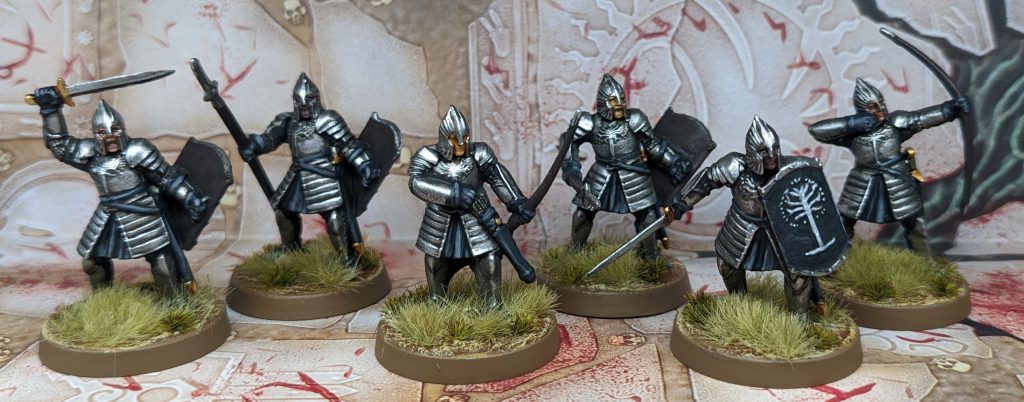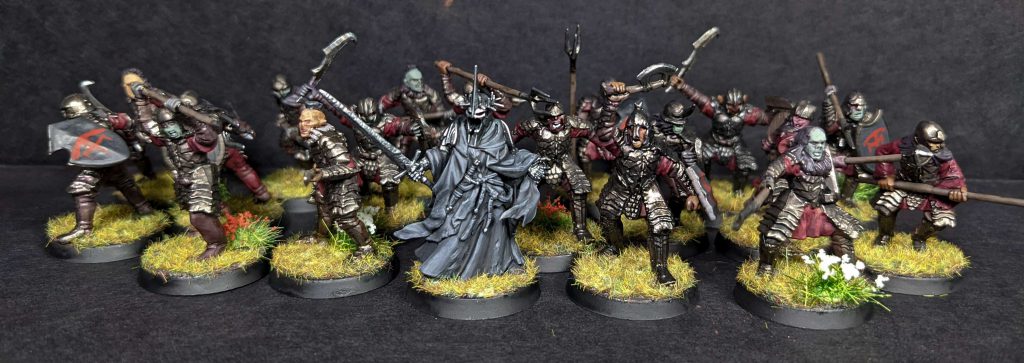In Lore Explainer, we take a deep look at the lore behind our favorite games, movies, and books, and talk about the story behind them and sum up what you need to know and how you can find out more.
“Silver flow the streams from Celos to Erui
In the green fields of Lebennin!
Tall grows the grass there. In the wind from the Sea
The white lilies sway,
And the golden bells are shaken of mallos and alfirin
In the green fields of Lebennin,
In the wind from the Sea!”
Though the realm of Gondor is greatly diminished by the time of the War of the Ring, it is still one of the strongest and greatest kingdoms in Middle Earth. It might not be as rich and prosperous as it was at its peak, but it benefits from good climate (it is roughly at the same latitude as Venice) and so many things grow in abundance there. It does not hold dominion over so many places as it once did, but it does rule over many fiefdoms and regions, and has within its borders ancient and grand cities. Its twin kingdom of Arnor has long fallen, but it has strong allies in the north nonetheless, with Rohan answering its calls to aid.
Of the Lands of Gondor
Gondor is bordered to the north by the White Mountains, and beyond that Rohan. Through the eastern part of the country runs the Anduin from north to south, dividing what was once western and eastern Gondor, though the lands to the east have all been lost. On the banks of the Anduin are the ruins of the old capital, Osgiliath, and to their west is the current capital and greatest city of the realm Minas Tirith. To the east of the river lie the lands of Ithilien in the north and then further to the south Harondor (which borders Harad where the Haradrim or Southrons) make their home), and though both of these were once parts of Gondor they have been lost to the ages. Past Ithilien is the corrupted tower of Minas Morgul, and beyond that the lands of Mordor, where the shadows lie.
It is to the west and south west of Minas Tirith that Gondor has much of its wealth then. The lush lands of the Lebennin, where much of its agriculture is, lie to the south and west of the capital, and the ancient city of Pelargir where the nation’s navy has traditionally been maintained is on the banks of the Anduin in that region. It is a land cut through with many small rivers and streams that make the land exceptionally fertile. Beyond them to the south is the Anduin delta and then the sea. The coast runs west to the region of Belfalas which is ruled by the Prince of Dol Amroth, a great city in that place. North of Belfalas is Dor-En-Ernil and then Lamedon, and while the lands of Gondor in theory continue for a good way further west than that into Anfalas, there are few major cities and large settlements that way.
Of Minas Tirith and Osgiliath

The capital in the time of the War of the Ring is Minas Tirith, the Tower of Guard, which was once known as Minas Anor, the Tower of the Sun. Minas Tirith is ruled directly by the House of the Stewards, and at the time of the War of the Ring this is Denethor II. Though in the movies he’s portrayed as a foolish, grasping old man, in the books he is quite different – old, and corrupted by his fear and paranoia of the rise of Mordor, but sharp and resourceful, brave and cunning. It is his depression and collapse in judgement brought on by Sauron infecting his mind through the Palantir that causes his spiral into despair, but before this he is an excellent ruler, noted to have been one of the greatest for many decades if not centuries. I fully recommend Bret Deveraux’s excellent series on the Siege of Gondor from the perspective of a historian, which goes into fantastic detail about what Denethor’s plan was and why it was so good.
Minas Tirith itself is a formidable bastion to try and take, as Mordor intend to do. The defences, already strong, had been strengthened first by Denethor’s predecessors, and then by Denethor himself. However, the city was in marked decline by the time of the War of the Ring, and many houses are empty and the population half that needed to fill the dwellings there. The defences themselves were made up of the Rammas Echor, a large ringwall that surrounded the city but also the Pelennor Fields. Unlike in the films, the books describe the fields as… fields. Intensely farmed agriculture, small dwellings, orchards, and so on. This was the breadbasket of the city, and an essential part of its wellbeing. The Rammas Echor was well maintained but too long to be manned seriously, and so it was part of a rolling defence used by Denethor during the Siege of Gondor… until Faramir was brought back wounded and Denethor collapsed into malaise.
The city itself was divided into seven tiers, each one hundred feet higher than the last and surrounded by a white wall (except for the first wall, which was black and built of the same indestructible material as Orthanc). The gates in each wall were not in a line, but instead opposite each other, which certainly would prove difficult to an invading force, but also must have been exhausting to live around. Finally at the top level was the citadel itself, which contained the barracks, armouries and so on.
Minas Tirith had under its command many knights of Gondor, but also a professional fighting force in the form of the Guards of the Tower. This was the personal bodyguard of the stewards and the guard of the citadel. They did not fight much during the War of the Ring, as they stayed at their posts rather than ride into the Pelennor fields, but we have good descriptions of their outfits unlike many of the warriors of Gondor that do take the field. They’re described as having chainmail of black steel, black tabards with a white tree emblazoned on it, and a silver winged helm (each of which was made of Mithril, and was a treasured and ancient relic). It’s suggested that this was similar to, but finer, than the equipment used by other knights of Gondor, so we can assume that chainmail, tabards (perhaps with the white tree device, but more likely with the heraldry of their fiefdom or lord) and helms were common.
To the east of Minas Tirith, about 20 miles away, lie the ruins of Osgiliath. Though it has long since fallen into ruin and the last bridges have been destroyed, Osgiliath is still a key strategic point of Gondor’s defences. Crossing the Anduin here is hard, but much easier than anywhere miles in any other direction, and indeed it is here that Mordor marshalls its forces to cross into western Gondor.
Of Ithilien and Minas Morgul

Beyond the banks of the Anduin to the east lie the lands of Ithilian. It stretches from the Dead Marshes and Morannon, the Black Gate, down past Minas Morgul to the river Poros which divides it from Harondor. Ithilien was once a flourishing part of the kingdom (and indeed it would be granted to the Steward Faramir to rule by King Aragorn, reincorporating it into their lands) but it fell into darkness years before the War of the Ring. Now the last of those fighting for it are the Rangers of Ithilien, who lead raids and harrying forces into the lands claimed by Sauron from refuges created for them by Gondor. These forces disrupt and ambush forces of the Enemy travelling through the wilderness. Camouflaged in green and brown cloaks, they fought mainly with bows and with stealth. Though they were all picked from descendents of those who had lived in Ithilien, it would not be until the Fourth Age that they really were inhabitants of the region again.
The reason for this, of course, is primarily the dark citadel of Minas Morgul, the Tower of Dark Sorcery. Once Minas Ithil, the Tower of the Moon, it was captured by the Witch-King and turned to the use of the Nazgûl soon after Arnor fell in the north. Since then it has been a thorn in the side of Gondor, a great threat from which armies have issued to challenge their rule. It was armies from Minas Morgul that led the assaults on Osgiliath that led to its final loss. At the time of the War of the Ring it is a bastion of darkness and horror unlike anything else in Middle Earth.
“A long-tilted valley, a deep gulf of shadow, ran back far into the mountains. Upon the further side, some way within the valley’s arms, high on a rocky seat upon Ephel Dúath, stood the walls and towers of Minas Morgul. All was dark about it, earth and sky, but it was lit with light. Not the light welling through the marble walls of Minas Ithil long ago, fair and radiant in the hollow of the hills. Paler indeed than the moon ailing in some slow eclipse was the light of it now, wavering and blowing like a noisome exhalation of decay, a corpse-light, a light that illuminated nothing.”
The main army that attacked Minas Tirith sallied forth from Minas Morgul in the Siege of Gondor. Later Aragorn and Gandalf would break the bridge leading to the cursed tower, and set the fields around it aflame in order to keep the last of the forces inside.
Of Dol Amroth and the Fiefdoms
The city from which the Princes of Dol Amroth rule the Fiefdom of Belfalas, Dol Amroth is ancient and powerful indeed. Founded originally in the Second Age by Faithful from Númenór, who settled close to an Elven settlement that dated to the First Age, the rulers were granted dominion over those lands by Elendil in perpetuity and the Princes of Dol Amroth were some of the strongest and most noble of the Gondorian aristocracy by the time of the War of the Ring.
Prince Imrahil took a small army with him to Minas Tirith to aid in the battle there, and his troops are noted as being unusual compared to the others arriving. They had gilded banners bearing Imrahil’s token of the Ship and the Silver Swan, and included a company of knights in full harness riding grey horses. Full harness in a historical sense usually refers to plate armour – and pretty comprehensive plate armour at that. Tolkien undoubtedly know what this meant, and so we have to assume that the Swan Knights of Dol Amroth were the only people in the entirety of Middle Earth to be wearing plate armour over chainmail, which is genuinely kind of awesome if very strange.
Not that the other fiefdoms didn’t send troops – some arrived at Minas Tirith along with the Prince of Dol Amroth, but others were held up at Pelargir. Their intention had been to sail up the Anduin to relieve the city, but the Corsairs of Umbar had taken the city and prevented this happening. In the books, Aragorn has the Army of the Dead drive the Corsairs off, and then leads a relief army of the fiefdom soldiers north to the Pelennor Fields on ships. It’s likely these forces were similar to the others described: some mounted knights, others on foot, mostly equipped with chainmail and tabards, with a mixture of archers, spearmen and more heavily armed and armoured cavalry.
Wrap Up
If you want to read more about the lands of Gondor, then the best places to start are The Lord of the Rings itself, and Book 12 of the History of Middle Earth, The Peoples of Middle Earth.
Have any questions or feedback? Drop us a note in the comments below or email us at contact@goonhammer.com.


